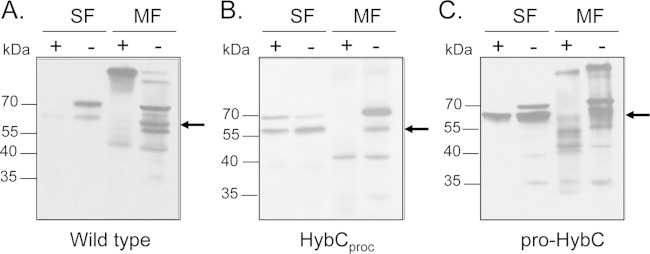FIG 4.
The Hyd-2 enzyme species, including NiFe-cofactor-free HybCproc, is sensitive to trypsin in E. coli spheroplasts. Anaerobically grown E. coli cells (50-ml cultures) were harvested by centrifugation for 5 min at 4,000 rpm at room temperature. The cell pellet was resuspended in 1 ml of 25% (wt/vol) sucrose, 30 mM Tris, pH 8.0, at room temperature. A 20-μl aliquot of 250 mM EDTA (pH 8.0) and 20 μl of freshly prepared lysozyme solution (10 mg/ml) were added, and the suspension was incubated for 3 min at room temperature. The spheroplasts were harvested by centrifugation at 15,000 × g for 30 s at 4°C. The supernatant contains the periplasm. The following steps were carried out at 4°C except as noted otherwise. Spheroplasts (pellet) were gently resuspended in the above-described buffer, trypsin (0.025%) was added, and the suspension was incubated for 10 min at room temperature. Trypsin inhibitor was added to a final concentration of 0.5% (wt/vol). Spheroplasts were separated by centrifugation at 15,000 × g for 10 min at 4°C. The pellet was resuspended in the same buffer, and after sonication the soluble cytoplasmic fraction (SF) and the membrane fraction (MF) were prepared by ultracentrifugation (2 h at 120,000 × g). Aliquots of the cytoplasmic and membrane fractions (50 μg of protein) from strains MC4100 (wild type) (A), FTD147 carrying plasmid p-HybCproc (HybCproc) (B), and FTD147 carrying plasmid p-proHybC (pro-HybC) (C) were separated by 12.5% (wt/vol) PAGE, and after transfer to nitrocellulose membranes, the blots were challenged with anti-Hyd-2 antiserum. The plus and minus signs indicate treatment with trypsin and nontreatment, respectively. The arrow indicates the migration position of processed HybC.

